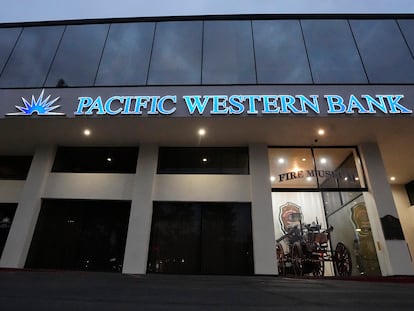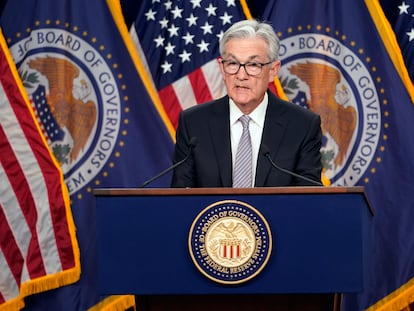Bank bailouts in the US: Dealing with a Lehman-sized collapse without using taxpayers’ money
The rescue packages for Silicon Valley Bank, Signature Bank and First Republic have been marked by a careful balance between state and private intervention

The United States is dealing with its worst banking crisis since 2008-2009. So far, the turmoil has seen three banks fail: Silicon Valley Bank (SVB), Signature Bank and First Republic. Between them, the three institutions accounted for assets totaling some $535 billion; Lehman Brothers held a similar amount when it went to the wall, making it the fourth largest financial entity in the country. Given the contagion experienced in the last financial crisis, the U.S. government had no option but to step in. However, unlike the bailouts witnessed 15 years ago, on this occasion authorities have been at pains not to see citizens pay the price of the banks’ mismanagement. As a result, the use of public money has been avoided and all deposits have been guaranteed.
President Joe Biden has repeated a message several times since authorities intervened in a bid to put an end to the crisis in mid-March: “No losses will be borne by the taxpayers,” he said during a White House address on March 13. “Instead, the money will come from the fees that banks pay into the Deposit Insurance Fund […]. Investors in the banks will not be protected. They knowingly took a risk and when the risk didn’t pay off, investors lose their money. That’s how capitalism works.”
In the main, the bailouts carried out have been characterized by a careful balance between state and private intervention. The cost of each rescue package has been covered by the money that the Federal Deposit Insurance Corporation (FDIC) obtains when it liquidates the bank, either by selling it to another financial institution or by auctioning its assets. Any cost beyond that is paid using the FDIC’s Deposit Insurance Fund, which is maintained by fees paid by participating banks and shareholders.
In parallel, the Bank Term Funding Program (BTFP) has been created. The BTFP is a scheme that offers loans of up to a year to banks, savings entities and other depository institutions that have liquidity problems. This instrument is backed up by $25 billion from a guarantee fund already in place at the Federal Reserve.
Although a buyer was sought for each bank, in the cases of SVB and Signature Bank, authorities weren’t going to have time to complete an auction before the institutions bled out completely. Amid fears that a mass flight of deposits could take other banks with it, supervisors had no option but to trigger a mechanism called the systemic risk exception, which entails closing the banks and naming the FDIC as their administrator. A so-called bridge bank was established to protect depositors and, until the sale of their assets, manage their banking activities and branches. This was the process followed with Signature Bank until an agreement was reached with Flagstar Bank, a subsidiary of the New York Community Bancorp, to take practically the entirety of the entity at an estimated cost of $2.5 billion.
In the case of First Republic, meanwhile, public intervention lasted only until U.S. authorities reached a deal that saw JPMorgan purchase the bank’s deposits and loan portfolio for $10.6 billion, a sum that went to the FDIC. As part of the agreement, both parties agreed to share the losses from First Republic’s residential and business loans, but the regulator doesn’t cover uninsured deposits, so they are to be guaranteed by the U.S.’s biggest bank.
This brings us to the third major difference between the bailouts of now and the Great Recession: coverage of deposits. Authorities have decided to ignore the $250,000 coverage limit and guarantee them all. This is a measure that seeks to avoid defaults among the entities’ clients, which in the case of SVB and First Republic were high-net-worth customers, venture-capital funds and technological start-ups. On the other hand, shareholders with any kind of instrument in these banks lost their investment.
This is different to what happened recently at the Swiss giant Credit Suisse, which was rescued in March by its competitor UBS, in a deal backed by Switzerland’s authorities. Under the terms of the purchase, shareholders received 0.76 Swiss francs per share. The only individuals who lost out in this agreement were those who held CoCos, or contingent convertible capital instruments. They lost all their money.
Following the failure of the banking crisis’ latest victim, the FDIC has proposed a reform to the system of guaranteeing the money of depositors at U.S. financial institutions, as it feels there is a need to give greater coverage to business payment accounts. What’s more, the agency is next week set to publish a proposal for replenishing its Deposit Guarantee Fund, which has been partly drained by the failures of Signature Bank, SVB and First Republic. According to plans revealed by anonymous sources to Bloomberg, the biggest banks would have to pay more money, given the size of their balances and their number of depositors. Meanwhile, entities with less than $10 billion in assets won’t have to pay. Per FDIC data, there were more than 4,000 banks below this threshold as of last year.
Depending on the size of their portfolio of deposits, some banks with up to $50 billion in assets will also avoid these payments, which could be spread over two years or paid up front, according to the sources spoken to by Bloomberg. The fees wouldn’t cover the $13 billion in estimated losses from the intervention in First Republic Bank; this hit will be paid for by regular quarterly contributions. Either way, it could be that First Republic Bank isn’t the final victim. On Thursday, two regional banks — PacWest and Western Alliance — plummeted on the stock market, and it is thought possible that buyers are being sought.
Sign up for our weekly newsletter to get more English-language news coverage from EL PAÍS USA Edition
Tu suscripción se está usando en otro dispositivo
¿Quieres añadir otro usuario a tu suscripción?
Si continúas leyendo en este dispositivo, no se podrá leer en el otro.
FlechaTu suscripción se está usando en otro dispositivo y solo puedes acceder a EL PAÍS desde un dispositivo a la vez.
Si quieres compartir tu cuenta, cambia tu suscripción a la modalidad Premium, así podrás añadir otro usuario. Cada uno accederá con su propia cuenta de email, lo que os permitirá personalizar vuestra experiencia en EL PAÍS.
¿Tienes una suscripción de empresa? Accede aquí para contratar más cuentas.
En el caso de no saber quién está usando tu cuenta, te recomendamos cambiar tu contraseña aquí.
Si decides continuar compartiendo tu cuenta, este mensaje se mostrará en tu dispositivo y en el de la otra persona que está usando tu cuenta de forma indefinida, afectando a tu experiencia de lectura. Puedes consultar aquí los términos y condiciones de la suscripción digital.
More information
Archived In
Últimas noticias
Most viewed
- Oona Chaplin: ‘I told James Cameron that I was living in a treehouse and starting a permaculture project with a friend’
- Reinhard Genzel, Nobel laureate in physics: ‘One-minute videos will never give you the truth’
- Sinaloa Cartel war is taking its toll on Los Chapitos
- Why the price of coffee has skyrocketed: from Brazilian plantations to specialty coffee houses
- Silver prices are going crazy: This is what’s fueling the rally











































